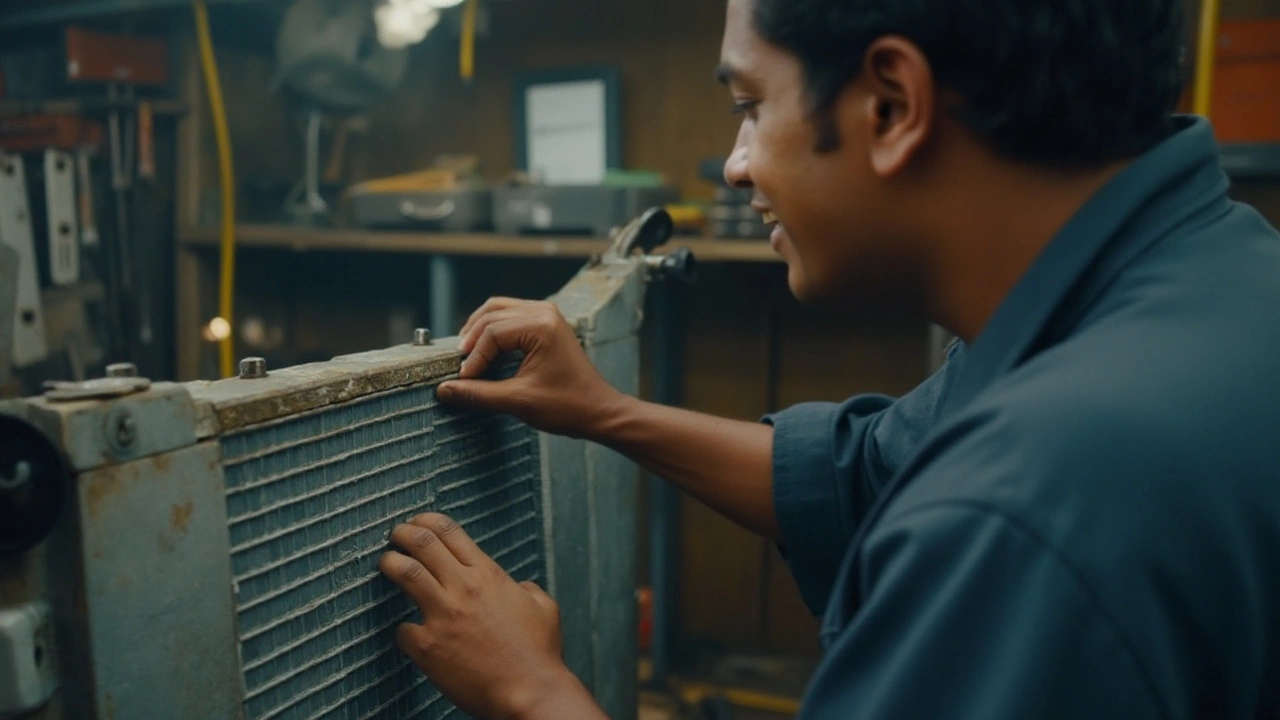 Jan, 24 2025
Jan, 24 2025
If you've ever asked yourself whether it's safe to drive a car with a faulty radiator, you're not alone. This conundrum is more common than one might think. Radiators are typically overlooked until they exhibit issues, which is ironic considering their vital role in keeping your engine cool and operational.
Before you find yourself stranded on the side of the road with steam billowing from under the hood, it's helpful to familiarize yourself with how your car's cooling system functions. Recognizing early signs of radiator trouble can be the difference between a simple repair and a costly engine overhaul. This article delves into the intricacies of car radiators, guiding you through what happens when things go awry, the potential dangers, and how you can prevent further damage.
- Understanding the Purpose of a Radiator
- Signs of a Faulty Radiator
- Risks of Driving with a Damaged Radiator
- Temporary Measures to Avoid Damage
- When to Seek Professional Help
- Tips for Radiator Maintenance
Understanding the Purpose of a Radiator
At the heart of every vehicle's cooling system lies the car radiator. It's a vital component, orchestrating a complex dance to regulate engine temperature and maintain the car's health. The engine itself is a hub of intense activity, where fuel combustion generates the energy needed to move the pistons and, ultimately, the entire vehicle. However, this process produces significant heat, and without an effective cooling system, an engine can quickly overheat, leading to catastrophic failure. The radiator's primary role is to dissipate this heat, ensuring the engine runs smoothly and efficiently.
To understand how the radiator accomplishes this, imagine it as a heat exchanger, tasked with transferring heat from the engine's coolant to the air outside. The coolant, a specially formulated liquid, absorbs the heat from the engine and flows into the radiator. Here, the heat is expelled as air passes over the radiator's intricate network of thin metal fins, cooling the liquid before it circulates back to the engine. This cycle is constant; it beats tirelessly at the heart of your vehicle's cooling system, ensuring temperatures stay within a safe range.
"A well-maintained cooling system can make the difference between a car that lasts a decade and one that fails after just a couple of years," notes Mark Jenkins, an automotive expert with over 20 years in the industry.
While all car radiators serve the basic function of heat dissipation, not all are created equal. Technological advances have led to variations in radiator design, from single-core to triple-core units, each suited to different engine demands and climates. Aluminum radiators, for instance, have gained popularity due to their impressive heat conduction properties and weight-saving benefits. Meanwhile, copper-brass radiators, though heavier, offer remarkable durability and repairability, making them a favorite among certain vehicle enthusiasts.
Understanding the purpose of a radiator also involves recognizing the signs of faulty performance. A well-functioning radiator should maintain optimal engine temperature efficiently. However, life on the road can be tough, and external factors like debris and rust can impair a radiator's efficiency. Proactive maintenance, therefore, becomes key—not just a matter of performance, but a commitment to your vehicle’s longevity. The typical lifespan of a radiator can vary; some last the vehicle's lifetime, while others may require replacement after eight to ten years.
For those keen on keeping their radiator, and in turn their vehicle, running optimally, understanding its purpose is the first step. This involves regular inspections for leaks, ensuring the coolant levels are consistently topped up with the right mixture, and keeping a watchful eye on temperature gauges while driving. Remember, the radiator is more than a passive player in your vehicle's story; it’s the unsung hero ensuring you're not left overheating on a busy highway.
Signs of a Faulty Radiator
Spotting the signs of a malfunctioning radiator can save you from impending disaster on the road. It's not just about the engine getting a bit hotter; it can lead to undetectable damage that creeps up and surprises you when least expected. One of the first telltale signs is the temperature gauge on your dashboard. If it's consistently higher than usual or touching the red zone, your radiator might be struggling to do its job. High temperatures often indicate that your cooling system isn't able to dissipate heat effectively, which is a screaming red flag you shouldn't ignore.
Another sign is the presence of coolant leaks. You might notice puddles of colorful liquid beneath your parked car. The vibrant fluid dripping on your driveway isn't an artsy statement; it's a sign that your radiator or one of the hoses has sprung a leak. This leakage reduces the coolant level in the system which, in turn, diminishes the radiator's ability to keep the engine from overheating. If left unattended, it can even lead to more severe engine damage. Vehicle maintenance shouldn't be underestimated when it comes to these signs, as they could save you from a significant headache down the line.
One audible cue often overlooked is the sound of a hissing or whining noise from under the hood. This sound usually occurs when there's a pressure problem within the radiator, or when air is trapped within the cooling system. Such an issue demands immediate observation as it might escalate into more serious complications if neglected. Keeping your ears on high alert while driving or even during a simple idle can provide crucial clues to your radiator's health. Additionally, frequent low coolant levels often hint at an internal radiator leak or even a faulty head gasket.
"Regularly monitoring your radiator's health is as critical as checking your tire pressure or oil levels," says automotive expert and best-selling mechanical author, James Clear.
A less obvious sign is reduced cabin heating during colder months. It sounds counterintuitive, but in cars, the heating system operates with the coolant from the engine; a failing radiator might mean the heater core is not receiving enough of this vital fluid to work effectively. So, if you're noticing subpar heating performance when it should be more robust, it might be time to check the radiator. Another symptom could be rust or discoloration on the radiator itself. A rusty radiator or a noticeable change in color often suggests internal corrosion or contamination.
Staying proactive about these warning signs not only safeguards the engine but also maintains fuel efficiency and extends the vehicle's lifespan. Remember, a car radiator is central to the vehicle's cooling system's effective operation. Identifying and reacting to these symptoms ensures that your vehicle remains reliable and roadworthy for as long as possible.

Risks of Driving with a Damaged Radiator
Driving a car with a damaged radiator is akin to playing a game of automotive roulette. With each turn of the key, you risk setting off a chain of mechanical failures that could reduce a sturdy, reliable machine into an immobile hunk of metal. At the heart of the issue is the engine, a complex ensemble of moving parts finely tuned to perform a symphony of chemical reactions. It is, however, a temperamental maestro that despises extremes. Even a slight dereliction of temperature control can unravel its harmony. The primary duty of a radiator is to siphon off the heat generated by combustion, maintaining a temperature sweet spot that keeps all the vaginal parts functioning smoothly. Without it, things can go south quickly.
When a radiator fails, the engine's heat has no place to dissipate. As the mercury rises, engines risk combustion chamber detonation or pre-ignition, where fuel ignites prematurely. This causes pinging noises and can damage the pistons, which, if left unaddressed, leads to expensive repairs. There's also the dire possibility of a blown head gasket, a consequence of prolonged exposure to excessive heat. A head gasket failure is a mechanic's nightmare, associated with symptoms like white exhaust smoke, coolant leaks, and, worst case, total engine failure. Such disasters also translate into out-of-pocket repairs that can easily edge into thousands of dollars.
“Running an engine without properly maintaining its cooling system is comparable to playing with fire: dangerous, avoidable, and potentially catastrophic,” warns Alex Donaldson, an experienced auto mechanic at AutoTech Solutions.
Beyond the immediate mechanical hazards, a damaged radiator poses environmental risks. Leaky coolants, comprised of ethylene glycol or propylene glycol, are harmful to both animals and water systems. A vehicle spilling coolant on the driveway or road increases the risk of ingestion by pets and wildlife, proving fatal in many cases. Such environmental consequences amplify the seriousness of timely radiator maintenance. Though the temptation exists to continue driving with a failing radiator, in hopes of saving a little time or money on immediate repairs, the reality is that this gamble is rarely worth it. The consequences are not only detrimental to the car's health but to your wallet and potentially the surroundings.
Interestingly, the risks associated with a bad radiator aren't just mechanical and ecological. There's a huge safety angle too. Imagine driving down the highway when the engine, already teetering on the brink due to overheating, suddenly seizes up. Situations such as this not only catch drivers off guard but can lead to high-speed accidents with dire consequences. The engine could lose power abruptly, resulting in a loss of steering and braking capability, increasing the chances of collision. It becomes evident that the humble car radiator, often underestimated, holds a pivotal role within the vehicle’s broader ecosystem, crucial for safeguarding its various parts, the environment, and most importantly, the lives it transports. Being proactive about radiator care is indeed more of a necessity than a luxury.
Temporary Measures to Avoid Damage
When your car's radiator starts to falter, the immediate goal is to prevent further damage to your engine. One short-term fix you can perform is to monitor your vehicle’s temperature consistently. Watch the dashboard's temperature gauge like a hawk—if the needle begins to creep into the red zone, it signals imminent overheating. In this scenario, it's best to pull over safely and let the engine cool down before proceeding. Plenty of motorists have discovered that patience here can save them costly repairs down the road.
Another technique to consider is adding coolant, but be sure the engine has cooled completely before you attempt this. Removing a radiator cap while it's hot can result in severe burns, so taking care is paramount. Once it’s safe, topping off with the right mixture of coolant and water ensures that the remaining contents circulate properly. According to a study by the American Automobile Association, about 20% of breakdowns are related to coolant problems, underscoring the importance of maintaining these levels. Vehicle maintenance doesn’t always demand an expert; sometimes, early intervention is key.
Some drivers resort to using a radiator sealant, a temporary solution that may stop minor leaks. These products are available at most automotive stores and are easy to apply by simply adding them to the radiator. Though not a permanent fix, they have helped many keep their vehicles running until a service shop is within reach. However, it's important to mention that sealants won't solve significant issues and should only serve as a stopgap measure. There's a fine line between too little and too much reliance on this method, and knowing when to call it quits is crucial.
Switching off the vehicle’s A/C and turning on the heater to full might sound counterintuitive, but this technique helps pull heat away from the engine. While it may not be ideal for your comfort, especially during summer months, it is a trick that has been known to reduce heat buildup considerably. In moments where the engine just can't seem to remain cool, every little strategy helps. Listening to stories of others who’ve managed similar challenges can offer you more insight and prepare you for the unexpected.
Finally, consider reducing your speed and avoiding heavy traffic situations where frequent stopping and idleness could exacerbate overheating issues. Operating your vehicle with gentle throttle can also lessen the load, allowing your car's beleaguered cooling system to catch a breath, so to speak. This slow and steady approach not only lessens strain but could also enhance your situational awareness on the road. The journey might take a little longer, but your engine will thank you for your care.

When to Seek Professional Help
Recognizing when to call in the experts could save you a substantial amount of money and inconvenience down the road. A radiator is part of a car's cooling system and plays a crucial role in maintaining the engine temperature within the optimal range. Despite your best efforts, sometimes problems manifest in ways that necessitate professional intervention. Imagine driving along, and suddenly you notice the temperature gauge creeping into the red zone. While it's tempting to press on and hope the issue resolves itself, this is often the point when a knowledgeable mechanic becomes your best ally.
One clear sign that professional help is needed is persistent overheating, which can indicate that there's more at play than just a simple coolant shortage. Repeated episodes could mean a leak in the radiator itself or more complex issues like a malfunctioning thermostat or a broken water pump. In some cases, mineral deposits may block the flow of coolant, leading to inefficient cooling and subsequent engine heat spikes. Another key indication is when your engine exhibits erratic temperature fluctuations. If the temperature shifts wildly from cold to hot, it’s likely that there’s a serious underlying issue requiring a trained eye to identify and fix. Moreover, leaks may be visible as pools of coolant under your vehicle, which requires immediate professional diagnosis to prevent engine damage.
Additionally, unusual noises, such as hissing or knocking coming from the engine bay, might point towards issues within the cooling system components that are beyond simple fixes. It's essential to understand that the complexity of modern cooling systems can make at-home diagnostics not only unreliable but potentially harmful. Driving, even for short distances, with an underperforming radiator might not only exacerbate the existing problem but also introduce new ones, leading to costly repairs. If you're uncertain about the specific issue troubling your cooling system, some vehicle manufacturers suggest consulting experts promptly to mitigate risks.
According to the AAA, nearly 30% of all car breakdowns are related to cooling system failures. Whether it’s a recurring need for refills or temperature gauge anomalies, dismissing these signs often leads to severe damage. To emphasize the importance of seeking expertise, remember what Dr. Henry Watson, a renowned automotive engineer once remarked,
"Ignoring the subtle cries of a failing cooling system is akin to courting catastrophe. A small investment in professional care can avert a significant crisis."In essence, a proactive approach not only preserves the life of your vehicle but also assures peace of mind by keeping you safe on the road.
Tips for Radiator Maintenance
Maintaining your car's radiator is crucial to ensuring the longevity and performance of your vehicle. A well-maintained radiator keeps your engine in excellent condition by controlling temperatures and preventing overheating. Several key practices can help you achieve this effectively. One important tip is to regularly check the radiator fluid or coolant level. This essential fluid helps maintain the optimal temperature of your engine. Every vehicle has specific recommendations for the type of coolant to use, so it's important to consult your car’s manual for guidance. Low coolant levels can lead to overheating, which if left unchecked, might cause irreversible damage to your engine. It’s advisable to check fluid levels every couple of weeks or before long trips, especially in extreme climates.
Another critical aspect of radiator maintenance is ensuring the radiator cap is functioning correctly. This often-overlooked component plays a pivotal role in maintaining the pressure required for the coolant to circulate through the cooling system. A faulty radiator cap can lead to leaks and a drop in pressure, potentially causing your engine to overheat. It’s a good practice to inspect the cap for any signs of wear or damage when checking the coolant level. If you're in doubt, replacing an old or worn-out cap is a minor investment in comparison to the cost of repairing an overheated engine. Regular flushing of the radiator is equally paramount. Over time, sediments and rust can build up inside the radiator, obstructing the coolant flow. Most experts recommend flushing your radiator approximately every 30,000 miles or as prescribed in your vehicle’s manual. This simple procedure involves draining the old coolant, cleaning the radiator with a flushing agent, and refilling it with fresh coolant to ensure the cooling system is debris-free.
"A consistently maintained radiator can add years to your vehicle's life," says Mike Johnson, an automotive expert at Car Care World.
Lastly, regular inspection of the radiator and its components can’t be stressed enough. Examine the entire cooling system for any signs of leakage, specifically around hoses and clamps. With age, hoses can become brittle and may fail unexpectedly. Look for discoloration or dry, cracked areas which are indications of an impending problem. Addressing these issues promptly can save you from getting stranded due to sudden coolant loss. Cleaning the exterior of your radiator is a straightforward maintenance tip often overlooked. Debris like leaves, dirt, and bugs can clog the radiator fins, hindering airflow needed for efficient cooling. Gently removing any obstructions with water or a soft brush can enhance its performance significantly. Remember, a clean radiator is a happy radiator.
Understanding statistics related to radiator performance can further bolster maintenance efforts.
| Component | Average Lifespan (Years) |
|---|---|
| Radiator | 8-10 |
| Hoses | 5 |
| Coolant | 2-3 |
Equipping yourself with these car radiator maintenance tips can make a substantial difference in reliability and longevity. Make sure you adhere to these practices regularly, and consult an automotive professional for any uncertainty. Whether it's the systematic fluid checks, periodic flushing, or component inspections, taking care of your radiator means taking care of your vehicle's heart.